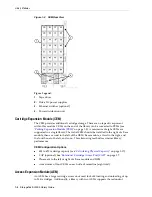
Hardware Components
Library Overview
1-7
Redundant Electronics
The optional redundant electronics (RE) feature is available for failover protection for
the HBCR controller card. With the RE feature, each library has two HBCR controller
cards. If the active library controller experiences errors, operations switch
automatically to the stand-by library controller, with minimal disruption to library and
host operations.
RE is not available for libraries that use the direct FC-SCSI connection to hosts.
"Redundant Electronics Overview"
Robotics
Each library can have either one (standard) or two robots (known as redundant
robotics). Robots retrieve and insert cartridges into CAPs or slots and mount or
dismount cartridges from tape drives.
Robots move along two rails on the rear wall of the library. One rail is at the top of the
library and one rail attaches to the floor. Two copper strips in the top rail provide
power and a signal path between the robot and library controller (HBCR) card. Power
is supplied from +48 VDC 1200 W load-sharing supplies (see
Robots contain a barcode scanner that reads the configuration blocks in each module
during library initialization and identifies volume serial numbers (VOLSERs) of
cartridges during CAP entries and audits.
Redundant Robotics
The optional redundant robotics feature increases the speed for robotic operations and
allows library operations to continue if one robot fails. Redundant robotics requires
240 VAC, 2N power, and either two PEMs or two AEMs.
Rotational Cartridge Access Port (CAP)
A CAP is a vertically-mounted, rotating cylinder with two removable 13-slot
magazines.
■
The Base module comes standard with a CAP.
■
The DEM and CEMs can have one optional CAP per module. Only the left PEM
can contain a CAP.
■
There can be a maximum of 10 rotational CAPs per library.
■
Each CAP has a keypad with an unlock indicator and a button to open the CAP.
Summary of Contents for StorageTek SL3000
Page 1: ...1 StorageTek SL3000 Library Guide E20875 15 December 2018...
Page 16: ...xvi...
Page 50: ...Ordering 1 32 StorageTek SL3000 Library Guide...
Page 62: ...Installation Tools 2 12 StorageTek SL3000 Library Guide...
Page 66: ...Installing Web launched SLC 3 4 StorageTek SL3000 Library Guide...
Page 74: ...Resolving Orphaned Cartridges Caused by Capacity Changes 6 4 StorageTek SL3000 Library Guide...
Page 88: ...Configuring Dual TCP IP 8 8 StorageTek SL3000 Library Guide...
Page 112: ...Stopping a Validation 12 4 StorageTek SL3000 Library Guide...
Page 124: ...Monitoring Library Events 15 6 StorageTek SL3000 Library Guide...
Page 128: ...Rebooting the Library 16 4 StorageTek SL3000 Library Guide...
Page 166: ...Downgrading Firmware D 4 StorageTek SL3000 Library Guide...
Page 183: ...Wall Diagrams Library Addressing Reference E 17 Figure E 14 Base Module Rear Wall...
Page 185: ...Wall Diagrams Library Addressing Reference E 19 Figure E 16 DEM Front Wall...
Page 186: ...Wall Diagrams E 20 StorageTek SL3000 Library Guide Figure E 17 DEM Front Wall continued...
Page 187: ...Wall Diagrams Library Addressing Reference E 21 Figure E 18 DEM Rear Wall...
Page 188: ...Wall Diagrams E 22 StorageTek SL3000 Library Guide Figure E 19 DEM Rear Wall continued...
Page 190: ...Wall Diagrams E 24 StorageTek SL3000 Library Guide Figure E 21 Cartridge Expansion Module Rear...
Page 191: ...Wall Diagrams Library Addressing Reference E 25 Figure E 22 Parking Expansion Module Left...
Page 192: ...Wall Diagrams E 26 StorageTek SL3000 Library Guide Figure E 23 Parking Expansion Module Right...
Page 193: ...Wall Diagrams Library Addressing Reference E 27 Figure E 24 Access Expansion Module Left...
Page 194: ...Wall Diagrams E 28 StorageTek SL3000 Library Guide Figure E 25 Access Expansion Module Right...
Page 202: ...Label Care F 8 StorageTek SL3000 Library Guide...
















































